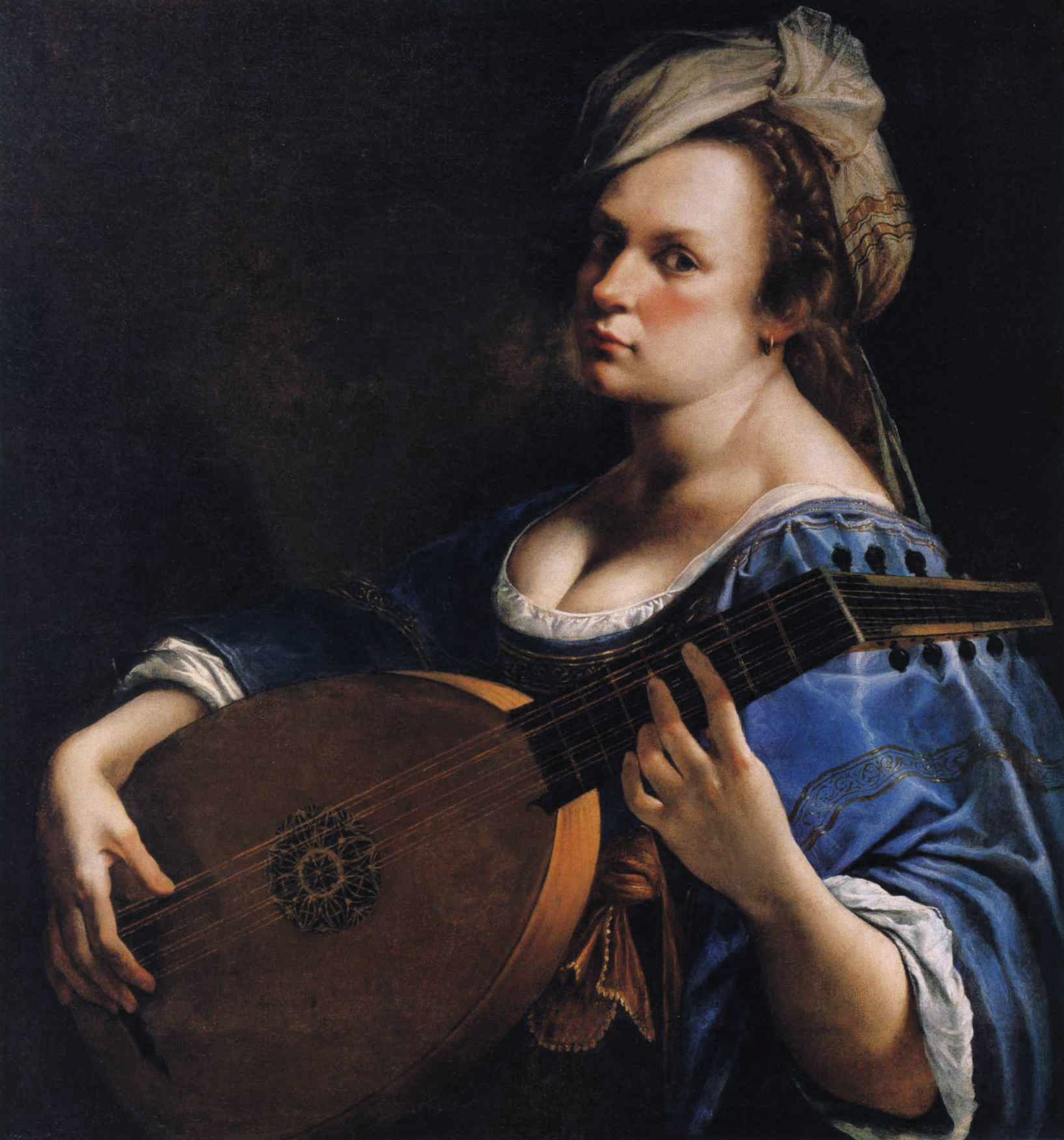
“I’ll Show You What a Woman Can Do”: The rise, fall and revival of an ‘Old Master’
by Francesca Carington | February 27, 2015
In January 2014, an important self-portrait by the Baroque artist Artemisia Gentileschi came up for sale at Christie’s New York. The canvas was the star lot of the auction, with an estimated price of three to five million dollars. Gentileschi was one of the leading artists of the Italian Baroque. Raped at the age of 17, she defiantly took her rapist to trial then went on to paint expressive canvases depicting both the suffering and triumph of biblical and mythological women. In the painting at Christie’s, the artist depicts herself as a lute-player dressed in a sumptuous low-cut blue gown, her starkly lit face gazing seriously back at the viewer from a black background. It is one of only three extant Gentileschi self-portraits. Yet astonishingly, the painting failed to sell.
Unusually for a girl in the 17th century, Artemisia was first taught to paint alongside her brothers by her father, the Roman artist Orazio Gentileschi. Her talent quickly eclipsed that of her brothers, and so Orazio arranged for her to be mentored by one of his artistic collaborators, Agostino Tassi. However, her father’s choice of tutor proved to be disastrous. In 1611, Tassi raped the teenage Artemisia. Tassi agreed to marry Artemisia, which in the eyes of 17th-century Roman society would have exculpated him and his crime. Nevertheless, Orazio chose to press charges in 1612 after it was revealed that Tassi already had a wife . Artemisia took part in the prosecution, but she was tortured with thumbscrews as she desperately tried to defend her reputation. At the end of the widely publicised trial, Tassi was found guilty of “presumed defloration and suborning of witnesses” and sentenced to five years of exile from Rome. However, the corrupt Roman legal system failed Artemisia once more and Tassi’s sentence was revoked. The court transcripts are still available today, preserved in the state archives in Rome.
It was during the trial that Artemisia produced her most celebrated painting, Judith Slaying Holofernes, which now hangs in the Museum of Capodimonte in Naples. The Biblical narrative recounts how Judith, with the help of her maidservant Abra, saves her people by decapitating the Assyrian general Holofernes when he tries to seduce her. The story has remained a popular subject throughout art history, though typically artists chose to focus on what follows the beheading. Cranach’s Judith proudly presents the viewer with Holofernes’s severed head. Botticelli’s heroine walks serenely from the scene of the crime, the Assyrian general’s head held aloft by Abra behind her. In shifting the focus of the paintings from the act to the aftermath, these depictions shy away from representing Judith’s agency, instead making her a symbol of female vice or virtue.
Artemisia dealt with the subject of Judith a number of times. In other versions, she too depicts the two women shortly after the crime. However, her most striking and visceral treatment of the Judith story is in the painting that emerged in 1612 at the time of the rape trial. It unusually shows the actual act of beheading, which empowers the subject as instrument of her own fate rather than as a moral symbol. Artemisia’s Judith hacks through her enemy’s neck with a sword, a look of cool detachment on her face, as her maidservant, Abra, forcefully holds him down. Holofernes fights desperately for his life and clenches Abra’s garments with his fist. His eyes roll back in terror and blood gushes out from his neck, staining the silk sheets beneath him. Holofernes’s futile resistance demonstrates Judith’s strength as she overpowers her adversary. The sleeves of her delicate gown are pushed up to reveal strong, almost manly arms; the femininity represented by her clothes is pushed aside by the brute force required for the gruesome deed.
Judith’s face, half-cast in shadow, half in shadow, is strikingly similar to that depicted in Artemisia’s self-portrait. The resemblance has led historians to argue that she imagined herself in the role of the Biblical heroine. In doing so, she brought symbolic retribution to the men that wronged her. Whether or not you regard the picture as Artemisia exorcising her personal demons, its visual power is undeniable. Her use of chiaroscuro, strong contrasts of light and shadow, drowns the background in darkness and throws the figures in the foreground into sharp relief. She places human drama at the centre of her painting. The heroine’s worth lies not in her symbolic function but in her physical and mental strength.
Although she remained unrecognised by art historians until relatively recently, Artemisia was highly successful during her lifetime. Her career, which at the time of her rape had already shown signs of great promise, flourished in its aftermath. Shortly after the trial, she married one of the witnesses, Pierantonio Stiattesi, and they moved to Florence, where she enjoyed huge success as a court painter. In 1616, she joined the Accademia del Disegno as its first female member, an accomplishment that wasn’t repeated for another fifty years. Her patrons included Cosimo de Medici and even Charles I.
Artemisia fell into relative obscurity towards the end of her life. Her reputation as a leading Baroque painter, long overshadowed by the famous rape trial, was only resurrected by feminist art historians towards the end of the 20th century. She received an honourable mention in Linda Nochlin’s ‘Why Have There Been No Great Women Artists?’ – the essay that essentially spearheaded feminist art theory following its publication in 1971. This paved the way for Guerrilla Girls, a feminist group founded in 1985 with the intention of waging war on sexism in art. They used Artemisia as one of their literal poster-girls, superimposing the famous gorilla head onto Gentileschi’s painting Susanna and the Elders, and questioned why her works had largely been ignored by art historians. It was then that she caught the public’s imagination and became the subject of several books. She was even the focus of the controversial 1997 French film Artemisia, though it insultingly portrayed her and her rapist Tassi as lovers.
The question remains whether Artemisia’s newfound fame extended beyond the silver screen and into the art market. George Gordon, an expert on Old Master paintings and co-chairman of Sotheby’s, argues that her painting failed to sell at Christie’s simply because the estimate was too high. The same painting was in fact sold at Sotheby’s in 1998 for £380,000. Perhaps Christie’s overestimated the growth in Artemisia’s appeal over the last 20 years, hoping her new-found recognition within critical circles would be enough to place her in the million-dollar bracket.
As Gordon explains, female Old Masters tend to perform well at auction, in part due to what he terms the “Linda Nochlin effect”. The explosive force of feminist art theory in the ‘70s and ‘80s was reflected by the success of female Old Masters in the art market. All the same, Gordon maintains that Artemisia’s popularity “surely has to do with art history, but it’s not out of balance… because her evident brilliance justifies it.” However, he does caution that “although art history and the art market ‘enjoy’ a relationship, it is not always a direct one”, hence Christie’s misjudgement of Artemisia’s appeal. For Gordon, “Artemisia Gentileschi was an outstanding Baroque painter, and her paintings fetch strong prices – but not obviously more than those of her peers.” Ultimately, the art market is a fickle place, governed by shifts in buying trends based arbitrarily on whatever periods or genres happen to be in fashion. With Old Masters currently being neglected in favour of contemporary art, Artemisia is not alone in failing to reach her reserve prices. But the value of Artemisia’s painting should be measured by its impact not its monetary worth. In a letter to her patron in 1649, Artemisia wrote: “I will show your most Illustrious Lordship what a woman can do.” Perhaps we’re finally ready to let her.




